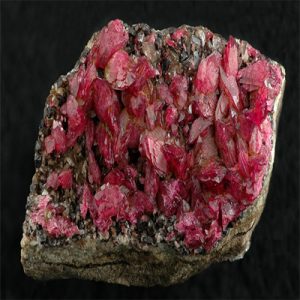Wendwilsonite
Wendwilsonite was named in 1987 by Pete J. Dunn, Bozidar Darko Sturman, Joseph A. Nelen in honor of Dr. Wendell E. Wilson (1946 – ), editor and publisher of the Mineralogical Record magazine since 1976, for his contributions to specimen mineralogy. Wilson was also the recipient of the Carnegie Mineralogical Award for 2001. The Mineralogical Recordmagazine is highly respected, award-winning and is the premier journal for serious mineral collectors. In 1982, The Mineralogical Record magazine became the first (and is still the only) journal ever to be honored with the naming of a new mineral species (Minrecordite), and again in 1994, when it became the first (and is still the only) journal ever to win the prestigious Carnegie Mineralogical Award.
Wendwilsonite is a rare secondary mineral in cobalt-bearing hydrothermal mineral deposits and is the magnesium (Mg) analogue of Roselite. In early 1985 Pete J. Dunn of the Department of Mineral Sciences, Smithsonian Institution, Washington, D.C., U.S.A. examined a pink mineral from Sterling Hill, New Jersey. Analysis of the mineral showed it to be almost identical to Roselite. However, Roselite has a cobalt (Co)-dominant chemistry and the samples from Sterling Hill, New Jersey as well as from Coahuila, Mexico and many from Bou Azzer, Morocco, proved to be magnesium (Mg)-dominant, and thus represented a new mineral species and the creation of the Roselite-Wendwilsonite Series. Samples of Wendwilsonite from Bou Azzer, Morocco consist of pink glassy crystals, up to 6 mm in size, associated with Talmessite and Erythrite on altered ore and Calcite gangue. At Sterling Hill, Wendwilsonite forms 0.5-mm crystals with Calcite crystals on a serpentine, which encrusts manganoan Calcite with very sparse Franklinite and Willemite. Only a few specimens are known, thus rare at this locality.
Distribution: From Bou Azzer, Morocco. At Sterling Hill, Ogdensburg, Sussex County, New Jersey, USA. From an unknown locality in Coahuila, Mexico.
| Chemical Formula: | Ca2(Mg,Co)(AsO4)2 • 2H2O; Often contains some Co replacing Mg. |
| Hydrated Calcium Magnesium Cobalt Arsenate | |
| Molecular Weight: | 426.99 gm |
| Composition: | Calcium | 18.77 % | Ca | 26.27 % | CaO |
| Magnesium | 4.27 % | Mg | 7.08 % | MgO | |
| Cobalt | 3.45 % | Co | 4.39 % | CoO | |
| Arsenic | 35.09 % | As | 53.83 % | As2O5 | |
| Hydrogen | 0.94 % | H | 8.44 % | H2O | |
| Oxygen | 37.47 % | O | |||
| 100.00 % | 100.00 % | = TOTAL OXIDE | |||
| Crystallography: | Monoclinic – Prismatic |
| Crystal Habit: | Crystals are stout prismatic, elongated along [100], showing {011}, {111}, {010}, {110}, to 6 mm. |
| Twinning: | On {100} as twin and composition plane; lamellar structure || {010}, {011}, {111} visible optically. |
| Cleavage: | Perfect on {010} |
| Fracture: | Irregular/Uneven |
| Tenacity: | Brittle |
| Moh’s Hardness: | 3.0 – 4.0 |
| Density: | 3.52 (g/cm3) |
| Luminescence: | None |
| Radioactivity: | Not Radioactive |
| Health Warning: | Contains arsenic – always wash hands after handling. Avoid inhaling dust when handling or breaking. Never lick or ingest. |
| Color: | Pale to intense pink, may be red; commonly color zoned |
| Transparency: | Transparent, Translucent |
| Luster: | Vitreous |
| Refractive Index: | 1.694 – 1.713 Biaxial ( + ) |
| Birefringence: | 0.019 |
| Dispersion: | Weak to distinct; r < v |
| Pleochroism: | X = violet-pink; Y = rose-pink; Z = colorless |


